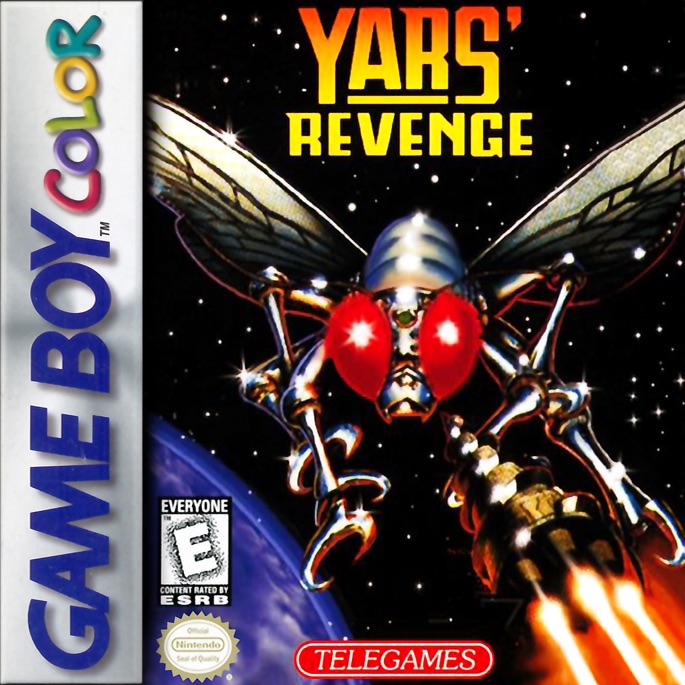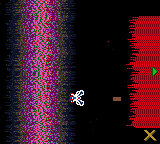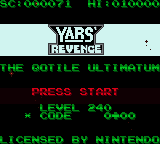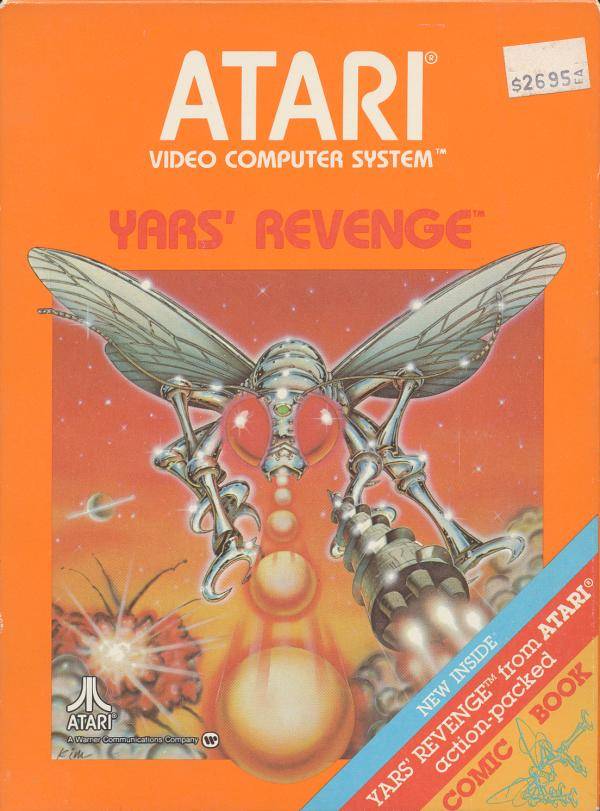Yars’ Revenge

- North American release in September 1999
- European release in 2000
- Never released in Japan
- Developed by Telegames
A One-man Show From a Different Age

I love sitting down on the couch, taking out my binders full of Game Boy cartridges and looking at the games I have, trying to pick something to play. You usually never play only one game in a single sitting; you instead go from one game to the other, indulging in different styles of games throughout your play session. Yars’ Revenge is the essential game to play between two bigger, more impressive games.
128 Bytes of Fun
Yars’ Revenge is the adaptation of an Atari VCS game released in 1982. Today, what is colloquially called the Atari is usually referred to as the Atari 2600. This is a second name given to the system in 1982 when its successor, the Atari 5200, was released. I personally prefer and use the original ’70s name: Atari Video Computer System. So nondescript.
On Game Boy Essentials, we talk about old games; Yars’ Revenge is old old. So old, the original Yars’ Revenge came out in what is usually called the golden age of video game development. Why? Games were completely made by one person, working alone with next to no supervision. Yars’ was literally made by one man; an employee of Atari, Howard Scott Warshaw. Warshaw made three games and three games only: Yars’ Revenge, Raiders of the Lost Ark and E.T. the Extraterrestrial. I know of no other programmer who can say they coded three games all on their own (Warshaw got artwork help for E.T. though but I think we can forgive him for that one) and they all sold more than a million copies. I’d say he quit while he was ahead but his last game is E.T. so, you know.
Anyway, Yars’ Revenge, Warshaw’s first game is a seminal classic for the Atari and is a great representation of its era of Atari VCS development. Gone were the early days in 1977 of catch all titles like Combat who proudly proclaimed to be 27 games in one. Yars’ Revenge was a one-trick pony, but a good one. If you can figure out how it works.
When I was a kid, I didn’t grok Yars’ Revenge. I was around 6 or 7 and I remember going to a friend’s house who had an Atari VCS stashed high up in a closet. This wood-panelled box of mystery was too interesting not to play. Plus, there was a box full of games with it! We’d get it, spend an eternity trying to figure how to plug it in and try all the cartridges. Yars’ Revenge was one of those games, and we just never figured out how it worked. We just played The Empire Strikes Back instead. That one was easier to figure out. My point is simple: Yars’ Revenge is not exactly self-explanatory if you don’t have the manual.
How to Play Yars’ Revenge
You are Yar, an insect tasked with destroying the Qotile (I know, it sounds stupid to me too) who moves up and down along the right side of the screen. The Qotile is a triangle that can do one thing: it sometimes turns into a whirlwind and lunges at you, trying to kill you. It then leaves the screen and reappears in its spot. The Qotile is surrounded by an orange shield that protects it. You can shoot a little bullet to destroy the shield piece by piece, but no matter what you do, your little bullet cannot harm the Qotile. To destroy it, you need to charge up your Zorlon Cannon (ridiculous names is one of the downsides of single person development) by eating pieces of the orange shield or touching the Qotile when it isn’t a whirlwind. This goes against every gaming reflex I have but you do have to touch the main enemy of the game to ultimately kill it. The cannon then shows up on the left side of the screen and you then need to aim it (it stays on the same axis as Yar) at the moving Qotile and fire it. If you lined up everything just right, boom! Interestingly, this is a composited screenshot I got from Wikipedia. The game seems to flicker between elements so no legitimate screenshot can show all the elements of the game.
Interestingly, this is a composited screenshot I got from Wikipedia. The game seems to flicker between elements so no legitimate screenshot can show all the elements of the game.
On top of that craziness, there’s the missile, relentlessly pursuing you. It’s not so much a missile as a silent rectangle stalker. It will constantly move in your direction, following you wherever you go; if you touch it, you’re dead. In the middle of the play field you have a safe zone where the missile will still pursue you but cannot kill you. That safe zone is a thing of beauty, built from a random block of the console’s RAM, constantly changing in random patterns. It’s coding gibberish turned into graphics. The VCS at its best.
When you clear a level it starts all over again with a different shield pattern and a faster missile and whirlwind. Repeat until you’re tired of playing it and want to play Save Mary instead.
Let’s Put It on Game Boy!
Let’s be clear here: Yars’ Revenge on Game Boy is not a shining diamond illuminating the Game Boy library. It’s just an Atari classic that sold like gangbusters in its time, somewhat adapted for Game Boy. How?
The most important consideration is a set of two glyphs on the right side of the screen. An arrow shows you where the Qotile is at all times, also warning you when a whirlwind is charging up. Since the play field is the same relative size as on the Atari, and the resolution is smaller, you need the arrow to keep you posted on where the Qotile is. It works surprisingly well.
On the bottom right of the screen, an arrow and X sign tells you what you need to do next. Go right to charge your Zorlon Cannon with the shield, now go left to arm it. Yeah, you need to go to the left side of the screen to arm your weapon; this is how modes 6 and 7 of the original game, affectionately called in the manual Ultimate Yars, worked. The cannon will not appear unless you touch the left side of the screen, and since the Game Boy has more than one button, you can still use your little pea shooter instead of being forced to fire the cannon when it is charged.
The two glyphs are positive points, but there are negative things. I don’t like the new sprite of Yar. While the original looked like an insect because its wings were flapping at a very fast rate, just like an insect, the new sprite’s wings flap too slowly. You don’t feel like you’re controlling a little bug. While I love the original’s game safe zone, the new one is uninspired. On top of that, where it ends is not clear. The only way to really know whether you are in it or not is to look at the X glyph on the bottom of the screen. This is dumb. The original was magnificently weird, and its borders were very clear.
The overall presentation is passable. I mean there are literally five screens that are not the game itself. Here they are:
Those screens are nothing special but the presentation’s brevity has the benefit of making sure you spend all of the game doing one thing: going through the gameplay loop.
The Gameplay Loop

With a game like Yars’ Revenge, one thing to keep in mind is that the game is the same short burst of gameplay repeated forever. The only change is a slight enemy speed increase or a difference in the shield of the enemy. The Game Boy version strangely adds the appearance of two new enemies: a kind of blue bullet that freezes you in place if you touch it and a weird squid that brings new shield parts that you can steal before they’re in place. They’re not very interesting, and honestly they start appearing so late in the levels as to not really matter. Their inclusion is puzzling. I had to put in a password to see them because I never played long enough otherwise to get to them.
To break the gameplay loop, the game introduces a weird bonus section. It is reached if you manage to touch a strange shadow of Yar that appears once the Qotile has exploded. It is an obvious attempt to keep the original game’s Easter egg alive. In the original game, if you destroyed the Qotile when it was hurtling towards you as the whirlwind and then you stayed vertical on the same angle as an empty line of the explosion, the initials of Warshaw would flash on the screen. Easter eggs were a trademark of Warshaw, and here the team at Telegames were clearly inspired to keep the easter egg alive with a bonus section.
In the bonus section, you have to navigate an asteroid field and stay on top of a ghost of Yar to get points. But the asteroids don’t kill you if you touch them, they instead push you back in a jigsaw fashion, just like the Qotile’s orange shield. The whole bonus mini game was obviously an afterthought reusing the physics systems they had already coded for the main game.
The Music
There is no music to speak of. The game features a varying array of digital VCS fart noises. They should have deviated from the original with that one. I guess you should turn the volume off and listen to something else while playing this game. It makes sense; the main character is a fly who keeps buzzing.
Conclusion

Yars’ Revenge is never on best-of lists because it’s not much to look at and you don’t take it seriously at first glance but it truly is essential in its own weird way. Yars’ Revenge is a good example of how to properly adapt a game for the Game Boy. It preserves the feedback loop of the original game, while trying to improve the game in subtle and mostly positive ways. It understands the resolution limitations of the screen and provides tools that allow you to have the proper awareness of things outside that screen. It does suffer from a poor art style: it has anemic pixel art, an absence of music and very weak transition screens. That presentation is amateurish and reeks of a small team left mostly unchecked. However, it’s a good project done adequately by a small team. They put their efforts where it mattered; the gameplay. I’m looking forward to trying their other games, to see if they pulled those projects off. Check Telegames out, their website is still up with a list of all their Game Boy titles!
This article was first published on the .
This article was last modified on the .